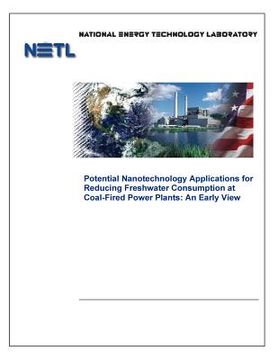Potential Nanotechnology Applications for Reducing Freshwater Consumption at Coal-Fired Power Plants: An Early View (en Inglés)
Reseña del libro "Potential Nanotechnology Applications for Reducing Freshwater Consumption at Coal-Fired Power Plants: An Early View (en Inglés)"
This book was funded by the U.S. Department of Energy's (DOE's) National Energy Technology Laboratory (NETL) Existing Plants Research Program, which has an energy-water research effort that focuses on water use at power plants. This study complements the overall research effort of the Existing Plants Research Program by evaluating water issues that could impact power plants.A growing challenge to the economic production of electricity from coal-fired power plants is the demand for freshwater, particularly in light of the projected trends for increasing demands and decreasing supplies of freshwater. Nanotechnology uses the unique chemical, physical, and biological properties that are associated with materials at the nanoscale to create and use materials, devices, and systems with new functions and properties. It is possible that nanotechnology may open the door to a variety of potentially interesting ways to reduce freshwater consumption at power plants.This book provides an overview of how applications of nanotechnology could potentially help reduce freshwater use at coal-fired power plants. It was developed by (1) identifying areas within a coal-fired power plant's operations where freshwater use occurs and could possibly be reduced, (2) conducting a literature review to identify potential applications of nanotechnology for facilitating such reductions, and (3) collecting additional information on potential applications from researchers and companies to clarify or expand on information obtained from the literature.Opportunities, areas, and processes for reducing freshwater use in coal-fired power plants considered in this report include the use of nontraditional waters in process and cooling water systems, carbon capture alternatives, more efficient processes for removing sulfur dioxide and nitrogen oxides, coolants that have higher thermal conductivities than water alone, energy storage options, and a variety of plant inefficiencies, which, if improved, would reduce energy use and concomitant water consumption. These inefficiencies include air heater inefficiencies, boiler corrosion, low operating temperatures, fuel inefficiencies, and older components that are subject to strain and failure.A variety of nanotechnology applications that could potentially be used to reduce the amount of freshwater consumed - either directly or indirectly - by these areas and activities was identified. These applications include membranes that use nanotechnology or contain nanomaterials for improved water purification and carbon capture; nano-based coatings and lubricants to insulate and reduce heat loss, inhibit corrosion, and improve fuel efficiency; nano-based catalysts and enzymes that improve fuel efficiency and improve sulfur removal efficiency; nanomaterials that can withstand high temperatures; nanofluids that have better heat transfer characteristics than water; nanosensors that can help identify strain and impact damage, detect and monitor water quality parameters, and measure mercury in flue gas; and batteries and capacitors that use nanotechnology to enable utility-scale storage.Most of these potential applications are in the research stage, and few have been deployed at coal-fired power plants. Moving from research to deployment in today's economic environment will be facilitated with federal support. Additional support for research development and deployment (RD&D) for some subset of these applications could lead to reductions in water consumption and could provide lessons learned that could be applied to future efforts. To take advantage of this situation, it is recommended that NETL pursue funding for further research, development, or deployment for one or more of the potential applications identified in this book.

